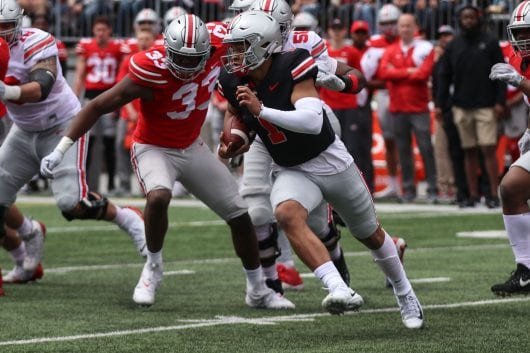
Sophomore quarterback Justin Fields (1) runs down the field in the first half of the 2019 Spring Game on April 13. Gray beat Scarlet 35-17. Credit: Casey Cascaldo | Multimedia Editor
Fans, students and reporters have waited months to hear what many assumed to be the case when Justin Fields transferred to Ohio State.
Head coach Ryan Day kept them waiting an hour longer.
At 12:17 p.m. — at a press conference originally scheduled for 11:15 a.m. — Day announced that the sophomore quarterback will start for the Buckeyes against Florida Atlantic Aug. 31.
“All guys had good camps, but Justin kind of separated himself last week. He’ll be the starter,” Day said. “I met with [the quarterbacks] and told them all that really means is Justin will be taking the first snap on Saturday.”
Now all the stories and discussions surrounding the Georgia transfer can pivot to focus solely on what he brings to the offense, as his knowledge of it continues to grow.
“I feel way more comfortable than in the spring,” Fields said. “When you get a hang of the playbook, you can play faster and the game slows down, and instead of reacting you anticipate what’s gonna happen.”
What stands out in comparison to Ohio State’s 2018 attack is Fields’ ability to run the football.
In 12 appearances serving as backup to Jake Fromm, Fields made 42 rushing attempts with just 39 passing attempts. He accumulated 266 yards on the ground.
Combined, Ohio State quarterbacks ran for 228 yards on 101 carries in 2018, four yards less per attempt than Fields, despite his limited play time.The Buckeyes will incorporate those abilities into 2018’s scheme.
“I mean, it’s going to be very, very similar. His skill set, he has a lot of different things that Dwayne [Haskins] had,” Day said. “He’s a little bit more athletic and faster and stronger. He can run.”
There’s a scale easily tipped when involving an athletic quarterback in any offense. Designed quarterback runs provide a unique look to defenses, and the ability to scramble and extend plays is good for a passing attack. The latter perk excites redshirt senior receiver C.J. Saunders.
“As receivers in the back half of routes, when he might get flushed out, he can make something happen with his feet,” Saunders said.
However, as Day pointed out, running quarterbacks are prone to injury when they take too many hits. A run-first mentality can also cause a gunslinger to scramble too early, creating the potential to miss open receivers.
Running smart wasn’t his focus at Georgia, Fields said. His goals on a play-by-play basis shifted because of his backup role, and as the season progresses, he’ll be learning when and how to run as a quarterback.
“Last year I was trying to make a play on every play,” Fields said. “Definitely have to be smarter this year.”
There are bound to be growing pains in his first season starting as a collegiate quarterback. By keeping his focus on the offense and feedback from coaches, Fields hopes to find success despite any issues.
“Coach Day talked about, in one of the team meetings, how the team shouldn’t look at the outside voices, because we’re the ones on the field actually playing,” Fields said.
His teammates are confident he’ll grow into the role with ease. He’s already been through plenty of growth from his transfer to spring football to the quarterback battle to 12:17 p.m. on Aug. 19.
“There’s been a big difference in him [from his arrival],” redshirt senior receiver K.J. Hill said. “He’s comfortable, feel like he felt like he was quarterback one and he acted like it. We fed off his energy.”


